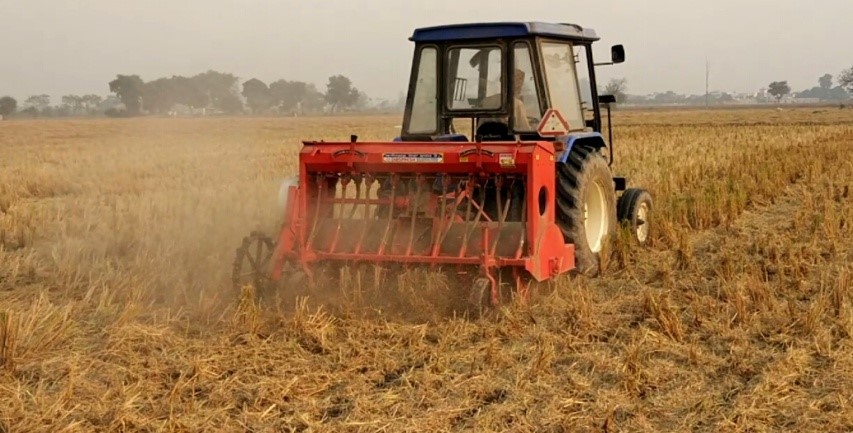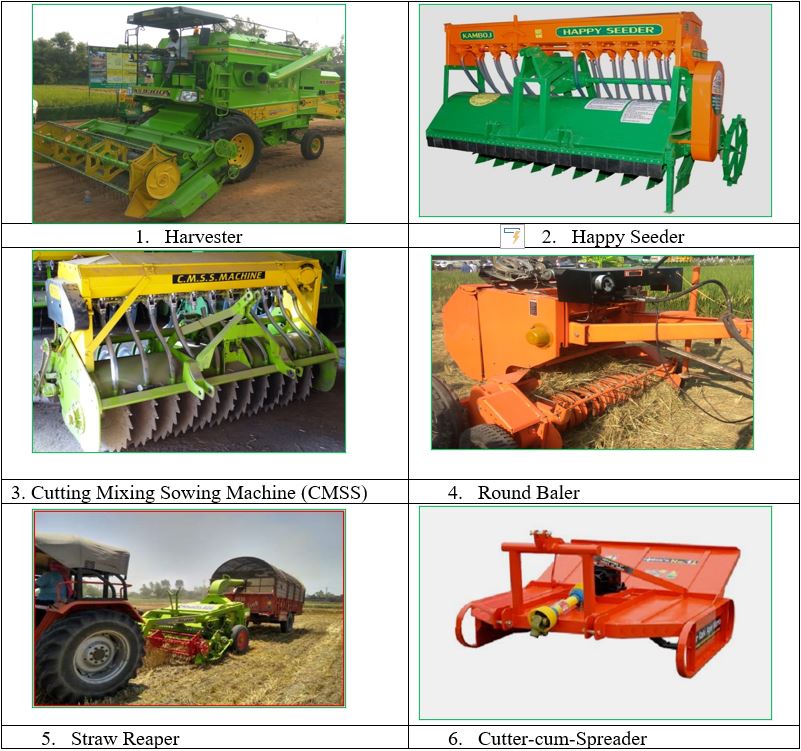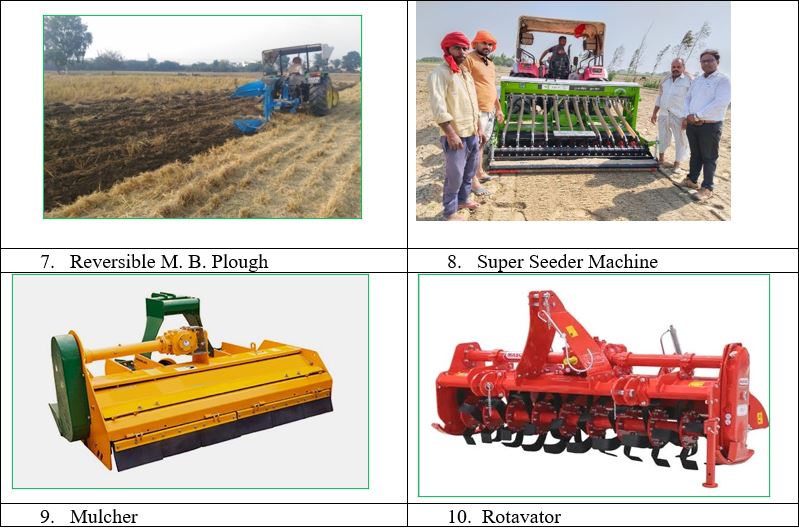Machine Bank under Crop Residue Management in UP
Devesh Kumar* and Arvind Kumar Singh Krishi Vigyan Kendra, Sant Kabir Nagar,
July 19th 2025, 11:27:48 pm | 5 min read

Indian agriculture is undergoing a gradual shift from dependence on human power and animal power to mechanical power because of the increasing cost of upkeep of animals and the growing scarcity of human labour. Further, the use of mechanical power has a direct bearing on the productivity of crops apart from reducing drudgery and facilitating the timeliness of agricultural operations. Thus, there is a strong need for taking farm mechanization. However, the farm power distribution is quite uneven across the States, wherein the highest use of mechanical power is in the order of 3.5 kW/ha in Punjab and less than 1 kW/ha in States like Bihar, Orissa Jharkhand etc. Mechanical power is largely consumed in big land holdings and is still beyond the reach of small/marginal holding which constitutes around 80% of the total land holdings. This is because the small/marginal farmers, by their economic condition, are unable to own farm machinery on their own or through institutional credit. Therefore, to make farm machinery available within the reach of small/marginal holdings, collective ownership or a Custom Hiring Centre needs to be promoted in a big way. This model scheme is prepared to demonstrate to the banks that financing for the establishment of a machinery bank is a financially viable unit.
Objectives:
1- To make available various farm machinery and equipment to small and marginal farmers
2- To offset the adverse economies of scale due to the high cost of individual ownership
3- To improve mechanization in places with low farm power availability
4- To provide hiring services for various agricultural machinery and implements applied for different operations.
5- To expand mechanized activities during cropping seasons in large areas, especially in small and marginal holdings.
6- To provide hiring services for various high-value crop-specific machines applied for different operations.
The main objective of this scheme is to provide machinery for farming on rent to the farmers. Farmers will be provided farming equipment on rent by opening a farm machinery bank through the Farm Machinery Bank scheme. So that it will be easier for them to cultivate. Anyone can open this bank. This bank will also become a very good source of income. Through this scheme, the economic condition of the farmers will improve and time will also be saved.
Potential for Machinery Bank:
The farm power availability for small/marginal land holdings is the lowest. As the small/marginal holdings constitute 80% of total land holdings, the potential for a machinery bank that will cater to the farm machinery requirement of such a vast area is quite huge. The government of India, in recognition of this potential, has envisaged an increase of farm power availability from the present level (0.93 kW/ha) to 2 kW/ha during the 12th plan period. The Sub Mission on Agricultural Machinery (SMAM) is one such initiative. The subsidy schemes are also being formulated to encourage entrepreneurs and agriculture graduates to set up machinery banks. Therefore, keeping in view the emphasis on agricultural farm machinery and the need for taking the farm machinery within the reach of small/marginal farmers, institutional credit needs to be made available for machine banks.
Mechanisation in Bihar has contributed significantly to the development of the agricultural economy of the state. But farmers with meagre resources at their command can’t go further for mechanization due to the high prices of machines such as tractors, combine harvesters, machinery for management of crop residues, etc. To overcome such problems and at the same time to get the advantages of mechanisation by the needy farmers for the costly machines and implements, some cooperative societies have initiated steps toward providing farm machinery services on rental as well as on a custom hiring basis to the farmers. Machinery bank neither needs initial investment nor repair and maintenance cost from farmers. It is well well-established fact that farm mechanisation helps in enhancing the production and productivity of agriculture. Costly and rarely used (required only for one or two farm operations) machines hinder farm mechanisation. Therefore, farmers, particularly small and marginal farmers cannot afford to purchase due to either higher cost or limited use of a particular machine. In such a situation, rural youth or farmers can establish a machine bank and provide the same to the farmers on a rental basis. A machine bank is a unit consisting of a set of machines, implements and equipment meant for custom hiring.

Fig 1: Operation of Happy Seeder in the field
Location of the Machinery Bank:
Ideally, the machinery bank shall have to be located in a place where by and large small land holdings are located within a radius of 5 to 7 kms. This will reduce the transport cost and time of transport of agricultural machinery. In other terms, one bank is expected to cater to 4/5 villages and therefore a commonplace equidistant from the villages catered to is advisable.
Advantages of Machine Bank:
Provides access to small and marginal farmers to costly farm machinery, Facilitates timeliness in farm operations and efficient use of inputs, Promotes adoption of climate resilient practices and technologies by farmers because of availability of appropriate machines at reasonable hiring charges, Reduces drudgery Promotes an increase in cropping intensity wherever feasible, Facilitates crop residue recycling and prevents burning of residues. Reduction in the cost of cultivation, Provides work opportunities to skilled labour and small artisans.
Farm Machinery Bank Unit:
A Farm Machinery bank is a unit comprising a set of farm machinery, implements and equipment meant for custom hiring by farmers. Though certain implements and equipment are crop-specific, traction units like tractors, power tillers etc., and self-propelled machinery like combine harvesters, balers etc., are used in common. Therefore, an ideal model envisaged in this project comprises farm machinery that is commonly used for tillage operations for all crops, multi-crop equipment and a minimum of crop-specific machinery.
Scenario of Residue Burning and Role of Machine:
Paddy-wheat cropping system is predominant in UP and has a lion’s share in the rice and wheat contribution to the national of food grain. Although mechanized harvesting and threshing of paddy using combine harvesters has reduced the cost of cultivation but also created the problem of paddy straw management. Paddy residue has emerged as a major challenge to contemporary agriculture in Bihar as disposal or utilization of the leftover residue in the short window of 10-20 days for timely planting of ensuing crops is a difficult task. Therefore, farmers generally resort to burning this paddy straw in the field itself. The amount of crop residues generated in India during 2009 was 501.76 million tons and the surplus amount was 140.84 million tons. According to an estimate, 92.81 million tons of crop residue were burnt in India in 2010 and Punjab, Haryana and Uttar Pradesh are leading states in crop residue burning (54.52%). Burning of these residues, to clear the field for the next crop, leads to atmospheric pollution, nutritional losses, deterioration of soil health, etc, Incorporation of this straw can augment the fertility of soil; thereby reducing the need for chemical fertilizers worth Rs. 1500-2000/ha. It seems to be a better approach as air pollution is prevented and soil fertility is improved with the existing residue in the field. Therefore, it is desirable to shun the residue burning for the benefit of farmers as well as the general public at large.
Among the scientific crop residue management options, ex-situ management of paddy residue is essentially the mining of essential nutrients from the field and should be avoided. However, in-situ management involves either retaining the residue on the field as a layer of mulch while sowing the succeeding crop with a happy seeder or zero-till drill or mixing/incorporating residue in the soil using reversible plough, disc plough or rotavator. The type of management and machines to be used can be chosen based on the requirements of the succeeding crop. Looking into the seriousness of the issue of residue burning in Utter Pradesh, as well as Krishi Vigyan Kendras (KVKs) of Bihar under the Department of Agriculture and Ministry of Agriculture has started pioneering work by promoting farm machinery for in-situ residue management and driving the attention of all the stakeholders to the problem of residue burning on small scale. Machinery for in-situ residue management has been the pre-requisite as most of the farmers particularly small and marginal farmers did not have it for the same.
Establishment of Machine Banks in KVKs:
Machine banks are established in each KVK of Bihar for organizing capacity development, demonstrations, and exhibitions as well as providing services to needy farmers. There are available machinery banks like Combine harvesters with SMS, Happy Seeders, Straw reaper, Strip Seeder, Super Seeder, Cutting mixing machines, Reversible Mould Board Ploughs, Shrub Master/ Cutter cum Spreader, Mulcher/Choppers, Zero Till Drills and rotavators available in different KVKs.
Scope for Income and Employment Generation:
Machine bank is an innovative solution for farm mechanisation and has tremendous potential for increasing the income of farmers as well as generating employment in rural areas. Rural youth can be attracted to establishing machine banks in their respective villages under the CRA Programme.
Table 1: Farm Machinery for in-situ Paddy Residue Management:
| Name of machine | Source of Power | Capacity/ output | Purpose |
| Combine harvester | Self-propelled, PTO operated /mount type | 7.0-8.0 acre/day | Combines the three major harvesting operations; reaping, threshing, and winnowing into a single process. Feeding, threshing, separating and Cleaning.
|
| Happy seeder | Tractor (50 HP or above) | 5.0-6.25 acre/day | Wheat can be directly drilled into combined harvested paddy fields without any burning or removal of residue. The loose straw should be uniformly spread in the field before sowing either manually or harvesting paddy with combined harvested fitted with Super SMS. |
| Straw cutter cum spreader | Tractor (50 HP or above) | 9-10 acre/ Day | It improves the efficiency (20%) of Happy Seeder by chopping and spreading straw after combined harvesting of paddy. |
| Paddy straw chopper/ mulcher | Tractor (50 HP or above) | 6-7 acre/day | The paddy straw chopper/mulcher chops the straw into small pieces and spread it on the surface. |
| Reversible MB plough | Tractor (50 HP or above) | 5.8-7.25 acre/day | Used to open up un-ploughed land. Field capacity will depend upon the size of the implement and soil conditions. |
| Zero-till- Drill | Tractor (40 HP or above) | 7-10 acre/ Day | Wheat can be sown directly in the clean paddy field without any tillage operation. It can be used in Basmati harvested fields or paddy fields from which straws have been manually removed. |


How farmers can benefit from Farm Machinery:
Modernization in the agriculture sector is increasing day by day; the need for new machines is being realized. Whether it is weeding or spraying and transplanting. But it is not easy for everyone to buy such expensive equipment. In such a situation, the central government itself has become a gathering. The Ministry of Agriculture has launched a scheme to build and take advantage of custom hiring centres. The officials associated with this scheme hope that when they get a rental instead of buying a machine, then the cost will be reduced, their income will increase and there will be no problem of debt. On the other hand, the government is providing financial support to the farmer who is doing its business.
Financial Assistance for Promotion of Mechanized Operations/hectare carried out through Machine Bank:
| Item | Maximum permissible cost | Pattern of Agency | Norms for Intervention |
| Hiring Charges to farmer members of Farm Machinery Banks set up under SMAM | Up to a maximum of 2 ha area as per following norms (i) For tractor/power operated operations – Rs. 2000/ha per farmer per year (ii) For animal drawn mechanized operations- Rs. 1000/ha per farmer per year (iii)For manual operations – Rs. 750/ha per farmer per year |
50% of the cost of operation/ha. | Selection of villages from districts with low productivity in Cereals, Pulses and oilseeds identified in other Missions for demonstrations One-time hiring assistance to farmer members of the farm machinery banks set up under SMAM |
| Field Demo by Machine Bank | Minimum 120 ha/season per machine bank |
Rs. 2000/ha | Demonstration charges to custom hiring centres set up under SMAM. These demonstrations will be limited to 120 ha/village |